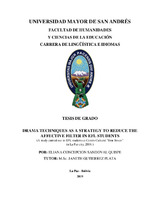Drama techniques as a strategy to reduce the affective filter in efl students : (A study carried out in EFL students at Centro Cultural "Don Bosco" in La Paz city, 2018.)
Fecha
2019Autor
Sandoval Quispe, Eliana Concepcion
Gutierrez Plata, Janeth (Tutora)
Metadatos
Mostrar el registro completo del ítemResumen
Nowadays, there are a lot of studies on English language learning, especially they are focused on the integration of content and a language. Many of these studies demonstrated that English language cannot be separated from the context in which it is carried out and the importance of affective factors and their influence in learning process. For that reason, it is essential that for English language learning activities and new strategies that suppose a reduction of the affective filter be developed, since a language is acquired and mastered more easily when students are motivated and have self-confidence and low level of anxiety (Krashen, 1982). This study contributes to the academic training with a series of theoretical and practical knowledge about drama techniques as a strategy to reduce the affective filter in EFL students at Centro Cultural "Don Bosco", that is why it is considered enriching and positive in the Linguistics and Languages Department. Likewise, it is important to state the structure of the content of the present investigation: The first chapter refers to the construction of the object of study, the justification, the problem is presented, the research question and objectives. The second chapter covers aspects where the state of art is defined and the theoretical framework in which the theoretical bases of traditional and drama techniques are detailed, as well as the affective filter and its components. The third chapter covers the methodological aspects of the research with reference to the research approach, type, design, the hypothesis, variables, the research techniques and instruments that allowed an approach to the research problem. The fourth chapter refers to the results of the research, systematized, analyzed and interpreted. They are presented in statistical graphs and tables in reference to the application of the Likert scale (quantitative analysis) and the analysis of data collected during the application of the techniques (qualitative analysis). In the fifth chapter the conclusions of the research are expressed, presenting them through objectives and the verification of the hypothesis of the research. Finally, it is going to be enunciated the recommendations of the investigation.

